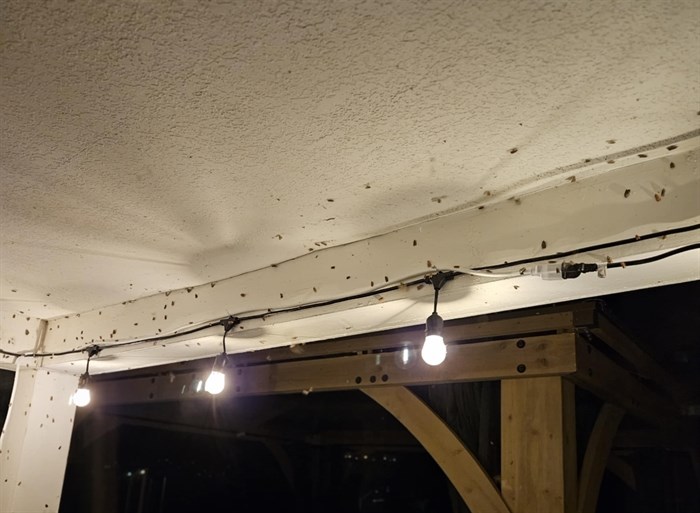
A patio at a Summerland residence was swarmed with moths for the first week of August.
Image Credit: SUBMITTED/ Lynne Basso
August 14, 2024 - 6:00 AM
This month, some residents in the Thompson-Okanagan saw swarms of hundreds or thousands of moths appear around their patios, on the surface of local lakes and under city street lights.
“It was crazy, and came on so suddenly,” said Summerland resident Lynne Basso whose patio was swarmed with moths for the first week of August.
“Lots of people around my town had similar experiences, a massive invasion of moths.”
The BC Interior is home to thousands of species of native moths, and while at times a nuisance, they come out in swarms for about a week at a time every summer, and it’s all to ensure the survival of their species.
“Insects in climates like ours are restricted in when and where they can do their business, they have a seasonal constraint,” said professor of forest sciences at UBC, Dr. Allan Carroll. “If winter rolls around and they’ve missed their opportunities, they’re done for.”
Moths evolved to have specific timing, first to emerge as larva when foliage emerges in the spring, then to pupate in late spring and later to swarm as adults in order to mate, lay eggs and create another generation.
“Moths only get a couple of weeks to do their business, so it must be timed properly,” Carroll said.
READ MORE: Bright blue tail of threatened species spotted on Penticton property
The swarming and mating process for moths takes roughly 10 days, but there are other insects, like mayflies that complete the process in a matter of days.
The blooms provide food for a wide variety of insects and animals and are part of normal ecosystem process.
READ MORE: iN VIDEO: Baby bat reunited with mother on south Okanagan property
The moths in the video were not clear enough for Carroll to identify the exact species.
For residents bothered by moth swarms, Matthew Wright of Orkin Canada in Kelowna suggests switching out porch lightbulbs to sodium vapour bulbs which give off more of a yellow light, less attractive to moths.
To contact a reporter for this story, email Shannon Ainslie or call 250-819-6089 or email the editor. You can also submit photos, videos or news tips to the newsroom and be entered to win a monthly prize draw.
We welcome your comments and opinions on our stories but play nice. We won't censor or delete comments unless they contain off-topic statements or links, unnecessary vulgarity, false facts, spam or obviously fake profiles. If you have any concerns about what you see in comments, email the editor in the link above. SUBSCRIBE to our awesome newsletter here.
News from © iNFOnews, 2024